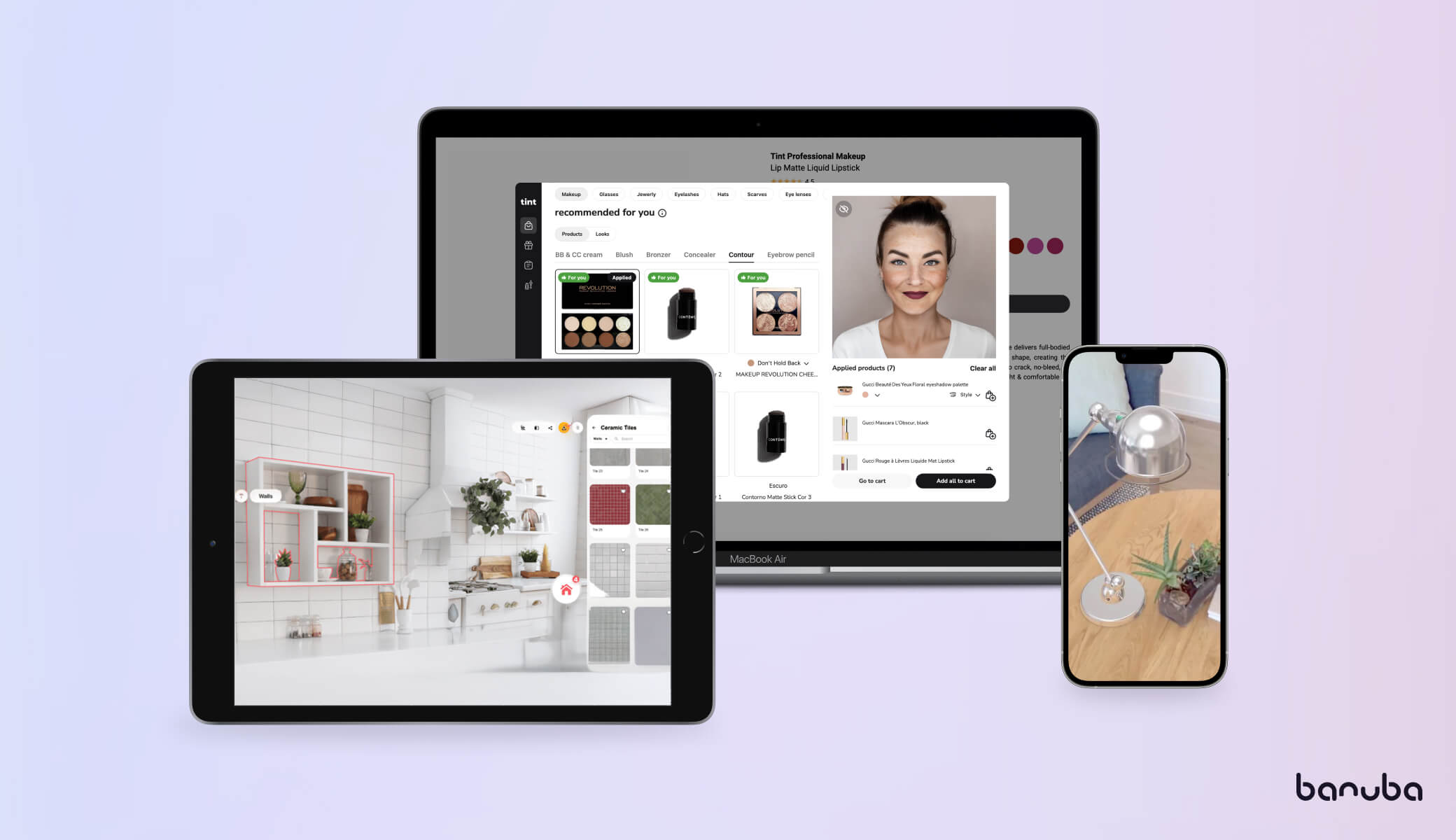19 Eye-Opening Stats of Augmented Reality for Business
AR technologies are becoming more integrated with multiple business domains. Entrepreneurs empower their operations with augmented reality technologies, whether it’s retail, e-commerce, education, or construction industries.
Here are the most impressive statistics and insights that show how close are we to augmented reality.
The consumer market numbers include:
- 2 in 3 customers say they would purchase more products if they used AR (ThinkMobiles)
- 6 in 10 customers state they prefer retailers with AR experiences (ThreeKit)
- 40% of customers state would pay more for goods if they could customize them in AR (ThreeKit)
- 100M customers used augmented reality to purchase goods/services in 2020 (ThreeKit)
- 1 in 3 customers use augmented reality while shopping (ThreeKit)
- 1.73B is the projected number of mobile AR users by 2024 (Statista)
- 1B customers used augmented reality in 2020 (TechJury)
- 2 in 3 users state AR can help them achieve new soft and hard skills (ISACA)
- 83M US-based consumers used augmented reality monthly in 2020 (ThreeKit)
- ~75% of the global population will become active AR users by 2025 (Snap Inc.)
- 100% of smartphone users will use AR daily by 2025 (Snap Inc.).
The business market insights include:
- $50B AR market value is expected by 2024 (ThreeKit)
- $18.8B is the amount spent worldwide on AR/VR in 2020 (ThreeKit)
- 2 in 3 advertising agencies state they are leveraging AR more actively.
- 1 in 4 retailers utilize AR in business for the sales phase (ThreeKit)
- 40% is the average number of increased conversion rates with augmented reality (ThreeKit)
- $340.16M is an average yearly AR revenue projected by 2028 (TechJury)
- 9 in 10 mid-sized businesses are actively using AR in business (Deloitte)
- $2B is the expected mobile AR Ad revenue by 2022 (The Manifest).
As you see, the usage of augmented reality in business is increasing.
The more AR technologies are in the market, the more benefits of AR your business will get.

How Is Augmented Reality Used In Businesses: 5 Use Cases
Here we want to share the 5 key use cases that show how is augmented reality used in businesses from retail to education.
You will explore both domains and their core examples.
Retail
The statistics above show that retail is among the most benefit-generating niches. And that’s vivid due to a large amount of the B2C segment.
So, how is augmented reality used in retail businessess?
AR-powered virtual try-on features.
Imagine you’re looking for a great couple of sunglasses for the upcoming vacation. Searching through the shops, you find the desired ones, but you’re not sure whether they would fit you well.
Here comes virtual try on functionality which helps you try before you buy.
Simply put, retailers use augmented reality in business to allow users try on goods in real-time with web or mobile cameras. Here’s an example of Gucci's virtual try-on feature in their mobile app.
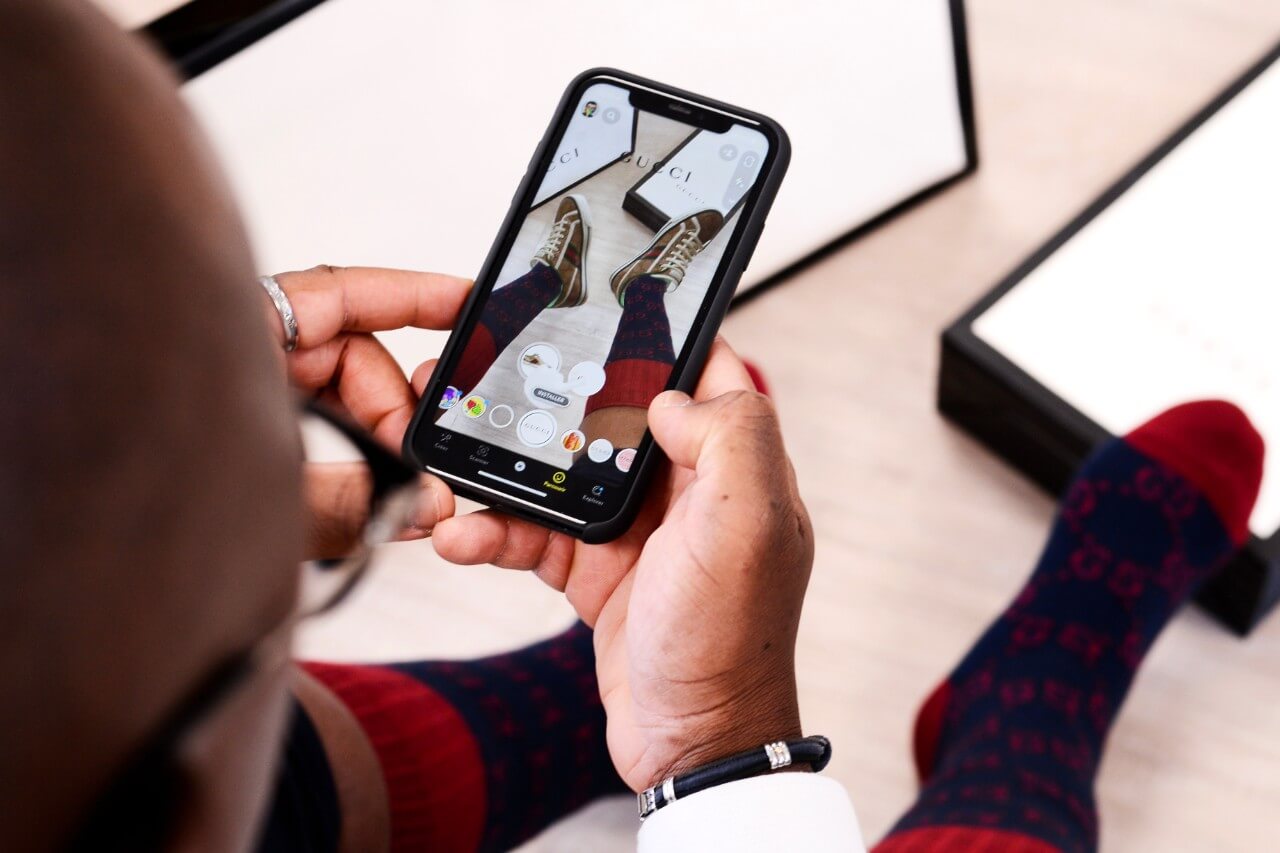 How Augmented Reality Helps Gucci
How Augmented Reality Helps Gucci
NOTE: virtual try on is one of the most popular, but not the only AR technology that retailers use to boost their business.
Cosmetics, eyewear, beauty, and fashion brands also use augmented reality in business. This way, they bring higher user engagement and value-added customer experience both online and in-store.
AR capabilities allow them to drive conversion rates by 40% on average. Now let’s check who uses augmented reality to empower their retail operations.

Gucci
The Italian high-end luxury fashion house is among the top examples of using AR in business. With the help of Banuba’s AR technologies, Gucci has implemented an in-app virtual try-on feature.
It helps customers customize their user experience and try products before they buy them.
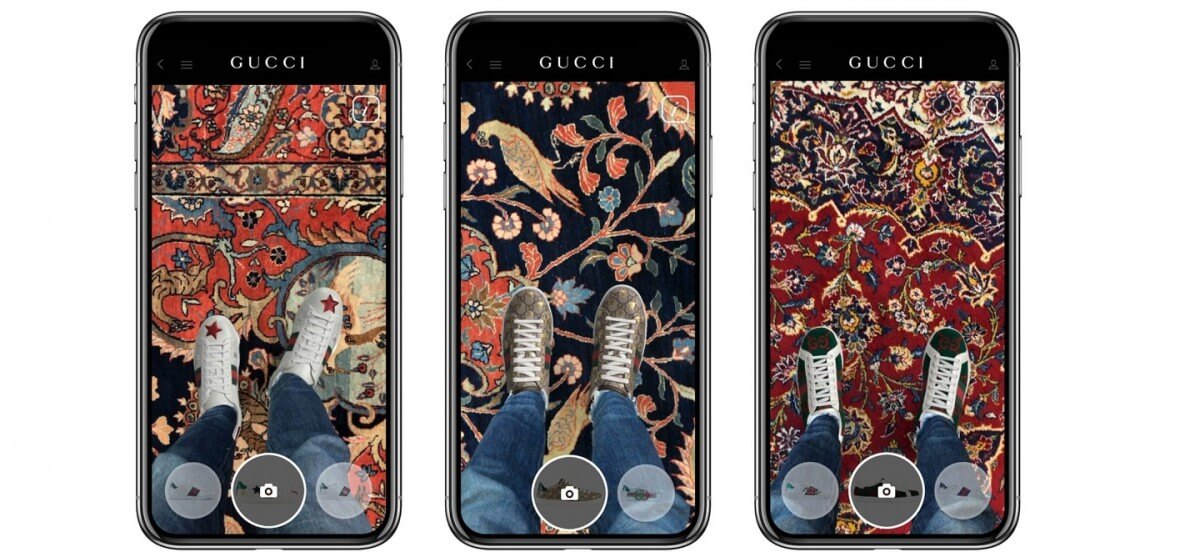 How Is Augmented Reality Used In Businesses | Gucci
How Is Augmented Reality Used In Businesses | Gucci
American Apparel
The popular online-only brand retailer has leveraged augmented reality in business as well.
American Apparel has launched an AR-powered application for customers.
It allows users to scan in-store items and get real-time details like colors, sizes, prices, and reviews.
Besides, customers can use AR features to customize products adjust their colors and watch videos with models wearing those goods.
This way, the brand offers cohesive and immersive AR experiences to customers.
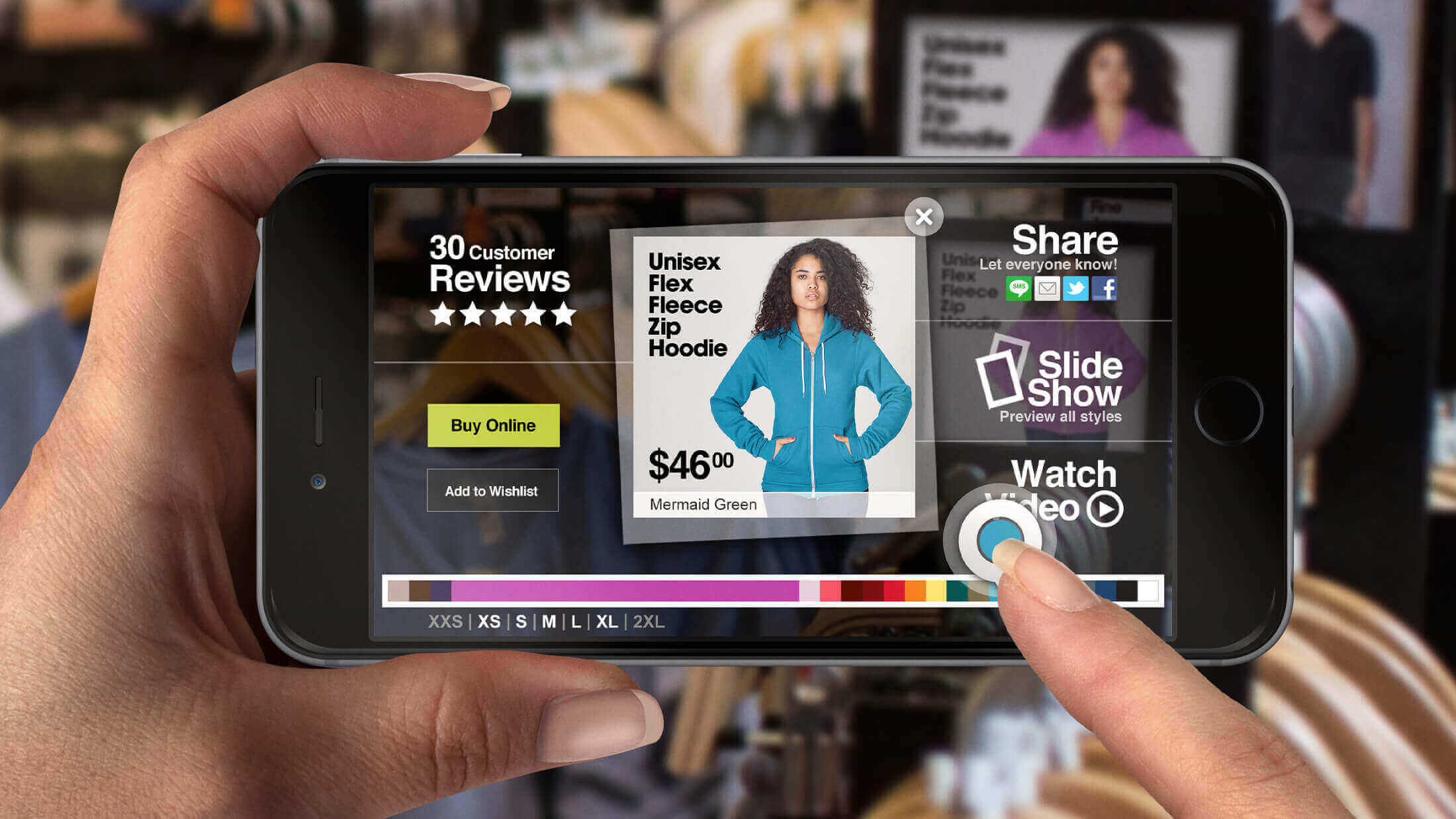 American Apparel | How Is Augmented Reality Used In Businesses
American Apparel | How Is Augmented Reality Used In Businesses
WatchBox
A popular brand buying, selling, and trading pre-owned luxury watches, WatchBox launched AR virtual try on experience. The technology allows customers to see how brand luxury watches will look on their wrists.
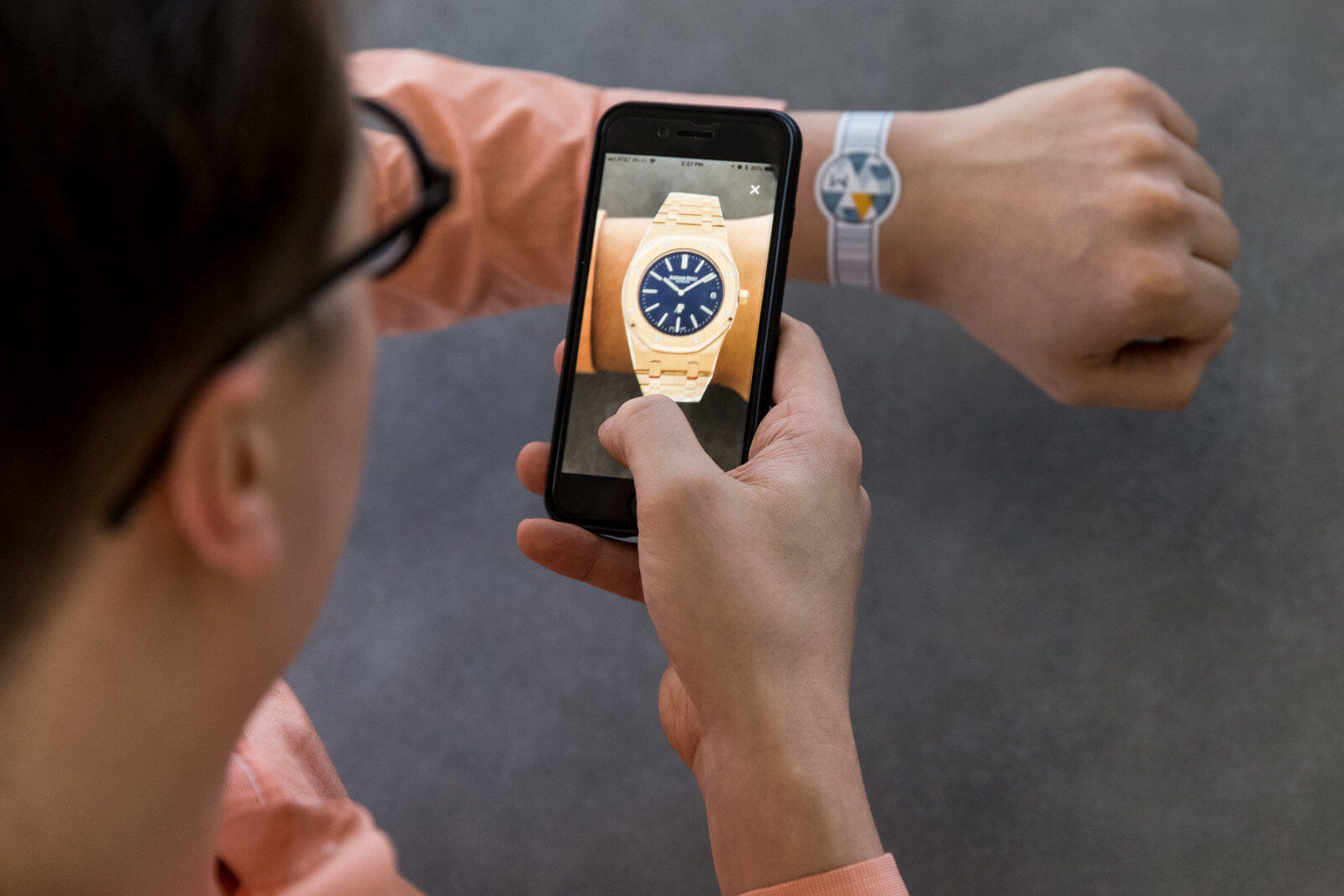 WatchBox | How Is Augmented Reality Used In Businesses
WatchBox | How Is Augmented Reality Used In Businesses
Healthcare
The healthcare industry is actively using AR technologies to enhance the way patients receive treatment. Also, medical professionals can now improve their performance by dividing mature concepts into engaging and interactive 3D forms.
What’s more, AR capabilities can enhance the way professionals get medical training from using MRI equipment to making complex surgeries.
MedCognition
MedCognition is showing how is augmented reality used in businesses and domains like healthcare. One of the leading technology-powered medical R&Ds building realistic simulators has launched PerSim.
It’s a complex AR-based training simulator program designed for pre-hospital professionals. They include EMTs, paramedics, nurses, or rapid response teams. Simply put, AR goggles help professionals train their skills dealing with virtual patients.
They can simulate sweating, seizuring, and other conditions that enable personnel to train trauma-related injuries and mass casualty events.
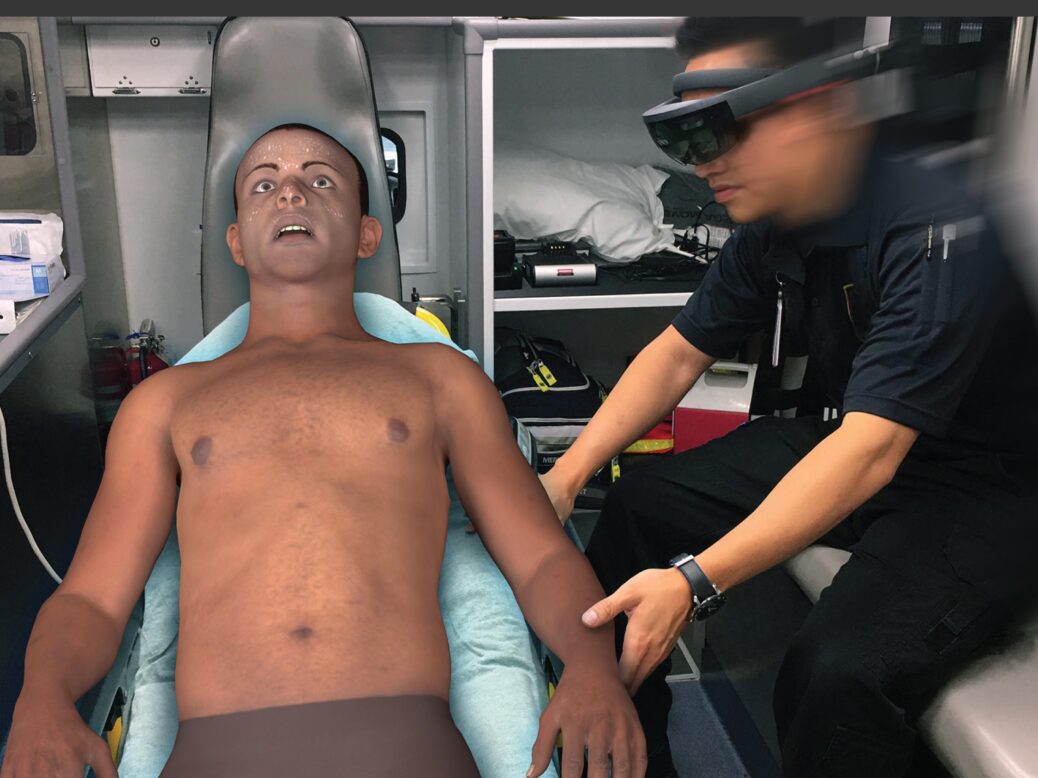 MedCognition | How Is Augmented Reality Used In Businesses
MedCognition | How Is Augmented Reality Used In Businesses
Gaming
The gaming industry is among the first and foremost markets that started leveraging AR capabilities to entertain and monetize. The global AR gaming market is expected to reach $38.03B by 2027 (IMARC Group).
In contrast, the market’s size in 2021 was only $6.39B. The matter of such large growth is the number of gaming users that is growing day by day.
AR capabilities in the gaming industry make user engagement way more interactive by adding lots of interactivities.
They enable gamers to take part in a more entertaining environment with virtual objects that seem to be real.
Pokémon Go
Pokémon Go is one of the most popular AR-powered mobile games in the world.
Since 2016, the game had over 750M app installs and the annual revenue reached $905M in 2021.
These figures show how perspective and fast-growing the AR mobile gaming market is.
So, Pokémon GO is an AR mobile game that allows users to find, capture, train, and battle augmented reality creations called Pokémons.
Simply put, users need to utilize their smartphone cameras to scan real-world locations and locate 3D visuals of virtual creations.
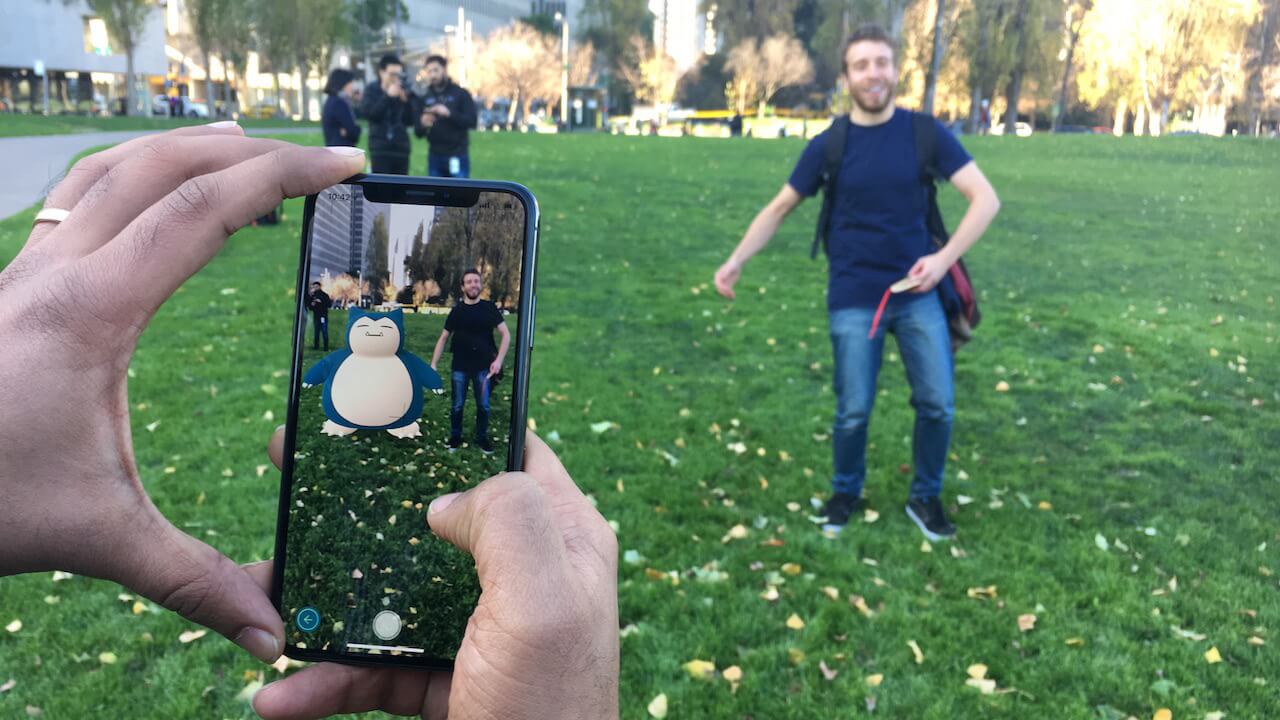 Pokémon GO | How Is Augmented Reality Used In Businesses
Pokémon GO | How Is Augmented Reality Used In Businesses
Real Estate
AR capabilities are gaining traction in the world of real estate. From 360-degree virtual tours to 3D renderings, the real estate market parties get a solid technology boost with augmented reality.
Here is a shortlist of AR-powered real estate solutions:
- Virtual property tours with immersive AR walkthroughs
- Real-time design staging and interior painting simulators
- Property space visualizations
- AR-based sales tools.
MagicPlan
MagicPlan is a great example of ow is augmented reality used in real estate businesses.
Simply put, it is a powerful AR-based real estate app for construction and floor planning activities.
Professionals can build and edit floor plans, view 3D spaces, plan projects, create estimates, and furnish properties.
AR capabilities allow real estate agents, architects, home inspectors, interior designers, and small businesses to improve their operations using augmented reality.
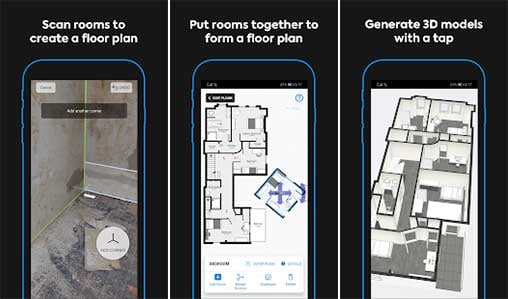 MagicPlan | How Is Augmented Reality Used In Businesses
MagicPlan | How Is Augmented Reality Used In Businesses
Travel and Tourism
AR technologies offer Geo-AR immersive experience to the travel industry.
It means users can utilize interactive maps and deal with 3D models to get real-time information about places, sightseeings, memorials, parks, hotels, restaurants, etc.
It becomes possible with the object recognition and image tagging functionality that helps users see augmented reality content in the real world.
World Around Me
The World Around Me app is an AR-powered local search guide.
It offers users to find places, build trips, measure distances, share items, and many others through a map, list, or camera views.
The latter is about AR technology.
Users can simply point their camera at a building or street to get detailed information related to that object.
This way, World Around Me increases user engagement and provides interactive content to make users entertained throughout their trip.
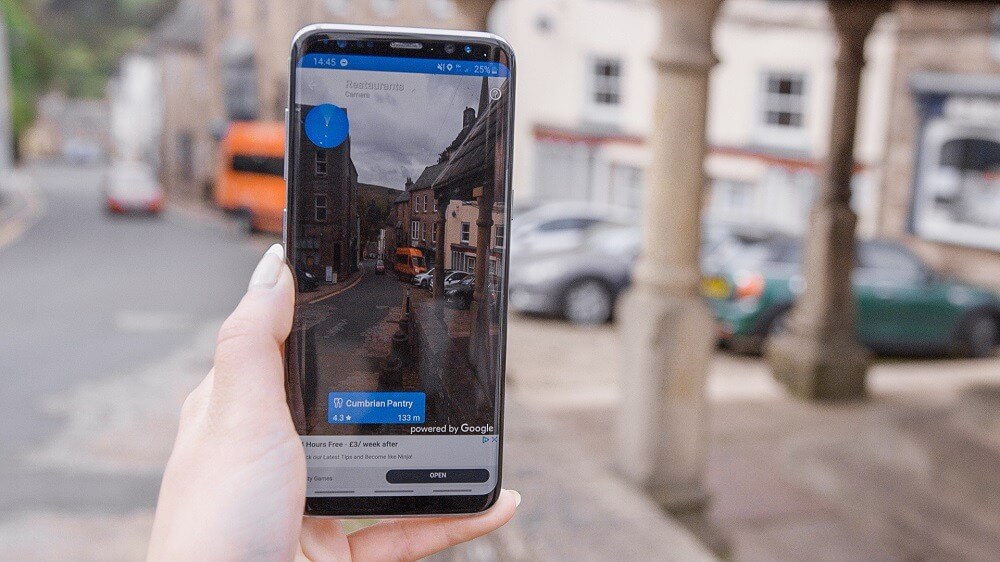 World Around Me | How Is Augmented Reality Used In Businesses
World Around Me | How Is Augmented Reality Used In Businesses
4 Benefits of Augmented Reality In Business
Stand Out from the Market
AR technologies help make your product unique.
Despite augmented reality is not new to most markets, it can still attract millions of users.
The matter is how you utilize it to address the needs of customers.
Make sure your AR-powered business offers more value than competitors do and there will be no gaps for competition.
What’s more, AR capabilities can exactly help your users save time and money compared to other market solutions. It helps to grow attention span and increase product usage metrics without struggling to solve common customer needs.
If your AR-powered product does that way, the chances are high to survive the early-stage competition and go viral.

High User Engagement and Retention
Augmented reality enables your customers to create user-generated content.
In turn, it’s about driving higher user engagement for your business.
Adsmurai states that user-generated content is almost 2x way more effective than branded content and has a 6.9x higher engagement rate.
There are multiple ways AR helps interact with users and motivates them to create user-generated content.
For example, augmented reality face filters.
They allow users to create, entertain, and share their customized and interactive photos and videos with others.
The more user-generated content customers build, the more loyalty your business gets.
It increases trust and inspires users to spend more time in your app thus increasing session time and retention rates.
The more users your business retents, the more revenue you generate.
This way, high user engagement and retention rates are among the core benefits of augmented reality in business.
On-of-a-Kind Customer Experience
Augmented reality in business is about offering unique digital experiences to users.
It allows you to connect both real and virtual worlds of customers into a whole.
This creates a mirage effect that inspires users to engage more with that kind of content compared to traditional experiences.
Let’s come back to Gucci’s virtual try-on feature one more time.
Isn’t it exciting and unique to combine both in-store and online experiences simultaneously?
First, users don’t need to physically visit offline stores and try on desired items.
It saves their time and resources.
Second, they can not only view sneakers, glasses, hats, and other products but also customize and test them in real-time.
Here comes the connection of both virtual and real worlds that offers a unique user experience.
This makes AR capabilities a win-win strategy for both your business and its customers.
Boost Sales by Times
Augmented reality is proven to evoke emotions among users.
The more emotions you provoke, the more decisions users can make.
Here comes the question of how to evoke positive emotions and stimulate customers to take an action?
AR capabilities close this gap again.
As we’ve discussed above, augmented reality virtual try-on features help users become more confident with their purchases beforehand.
And this leads to a decreased product return rate.
According to the study, the usage of AR in business, especially the virtual try-on feature, helps companies decrease the return rate by 27%.
In turn, this helps your business to drive sales.
61% of online customers prefer to make purchases in shops with an AR try-on feature onboard according to ThinkMobiles.
This way, AR technologies help your business thrive addressing both the needs of customers and your KPIs.
Wrapping Up
Your business can leverage multiple benefits of AR technologies and drive growth.
We hope our guide on the key benefits of augmented reality will help you better realize how you can use them for your specific niche.

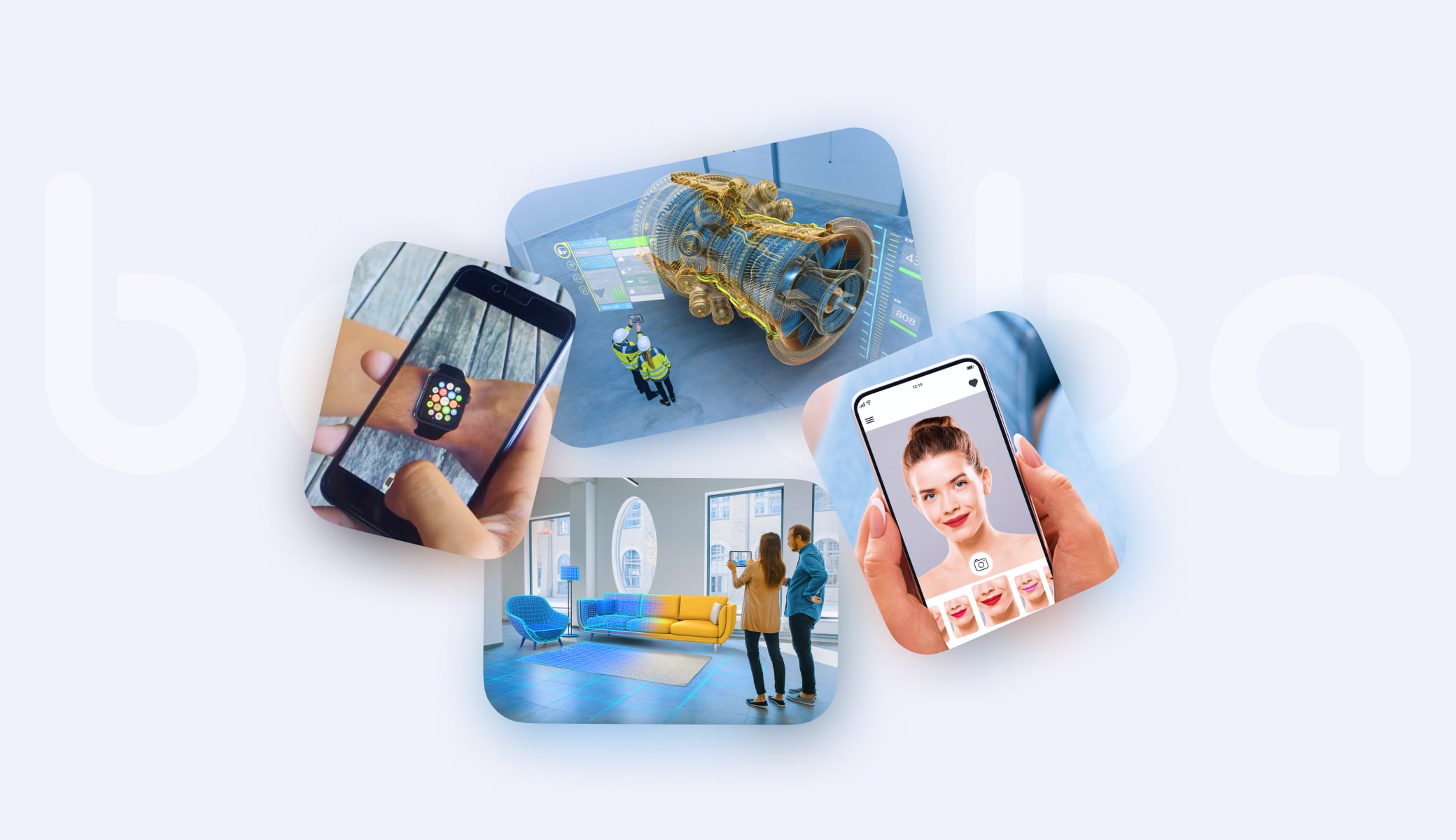


 How Augmented Reality Helps Gucci
How Augmented Reality Helps Gucci How Is Augmented Reality Used In Businesses | Gucci
How Is Augmented Reality Used In Businesses | Gucci American Apparel | How Is Augmented Reality Used In Businesses
American Apparel | How Is Augmented Reality Used In Businesses WatchBox | How Is Augmented Reality Used In Businesses
WatchBox | How Is Augmented Reality Used In Businesses MedCognition | How Is Augmented Reality Used In Businesses
MedCognition | How Is Augmented Reality Used In Businesses Pokémon GO | How Is Augmented Reality Used In Businesses
Pokémon GO | How Is Augmented Reality Used In Businesses MagicPlan | How Is Augmented Reality Used In Businesses
MagicPlan | How Is Augmented Reality Used In Businesses World Around Me | How Is Augmented Reality Used In Businesses
World Around Me | How Is Augmented Reality Used In Businesses
